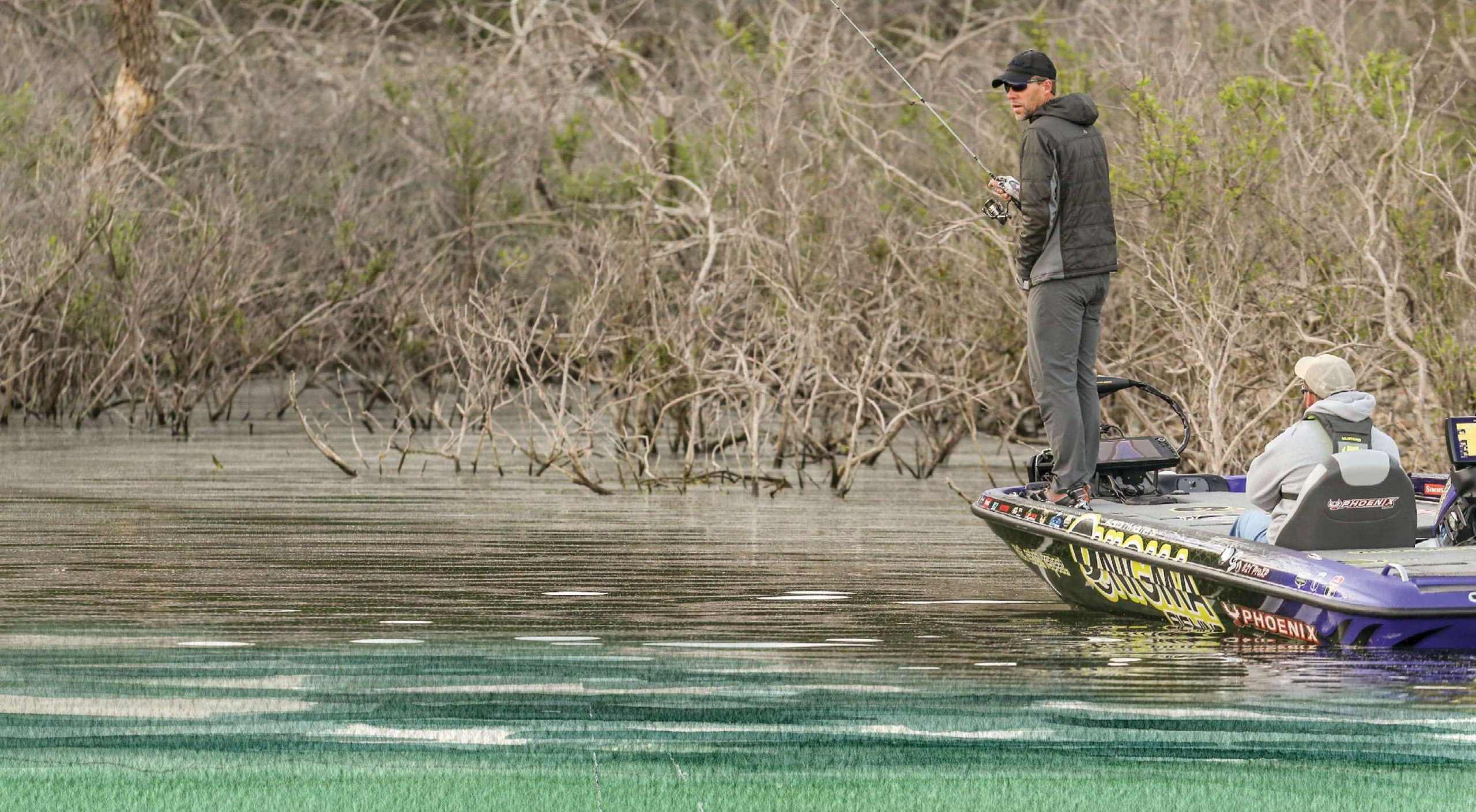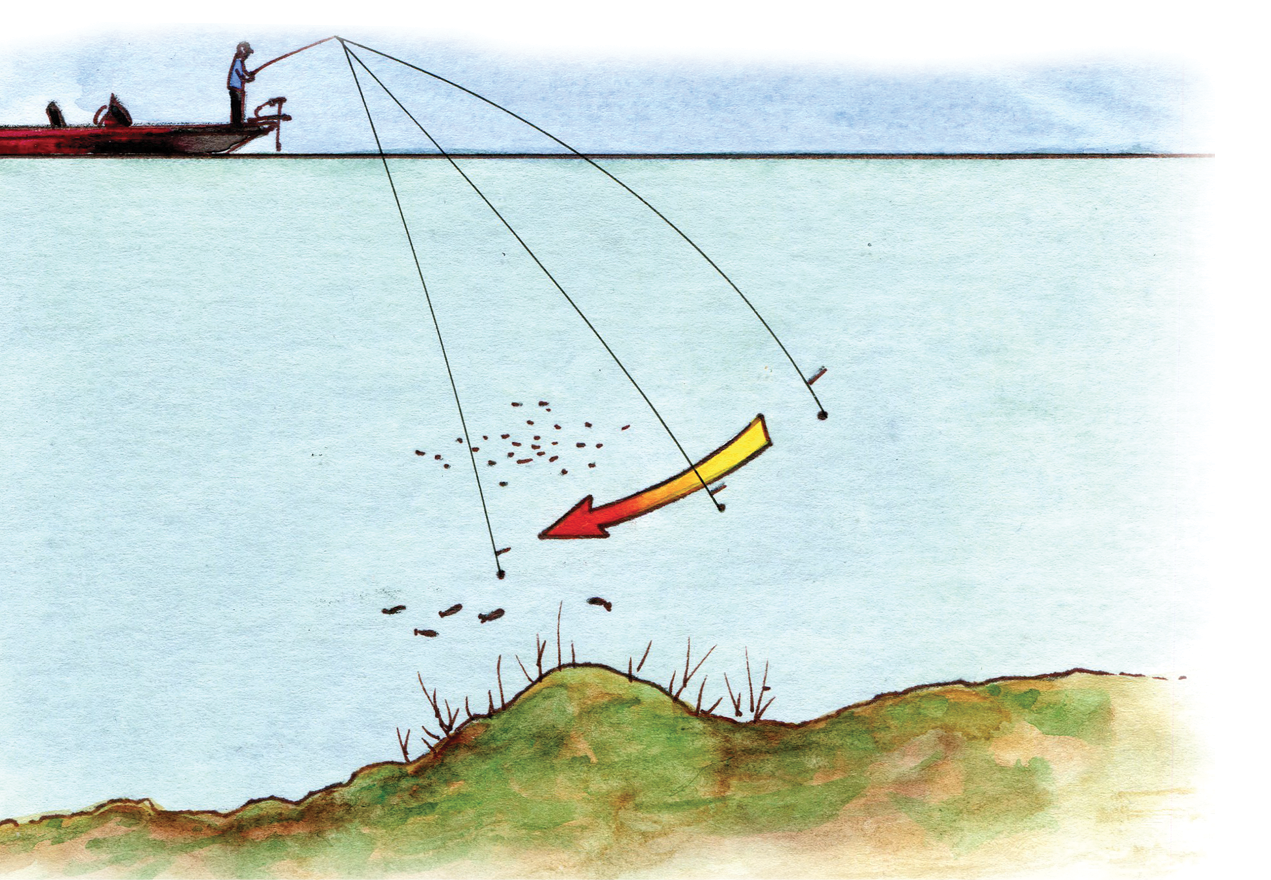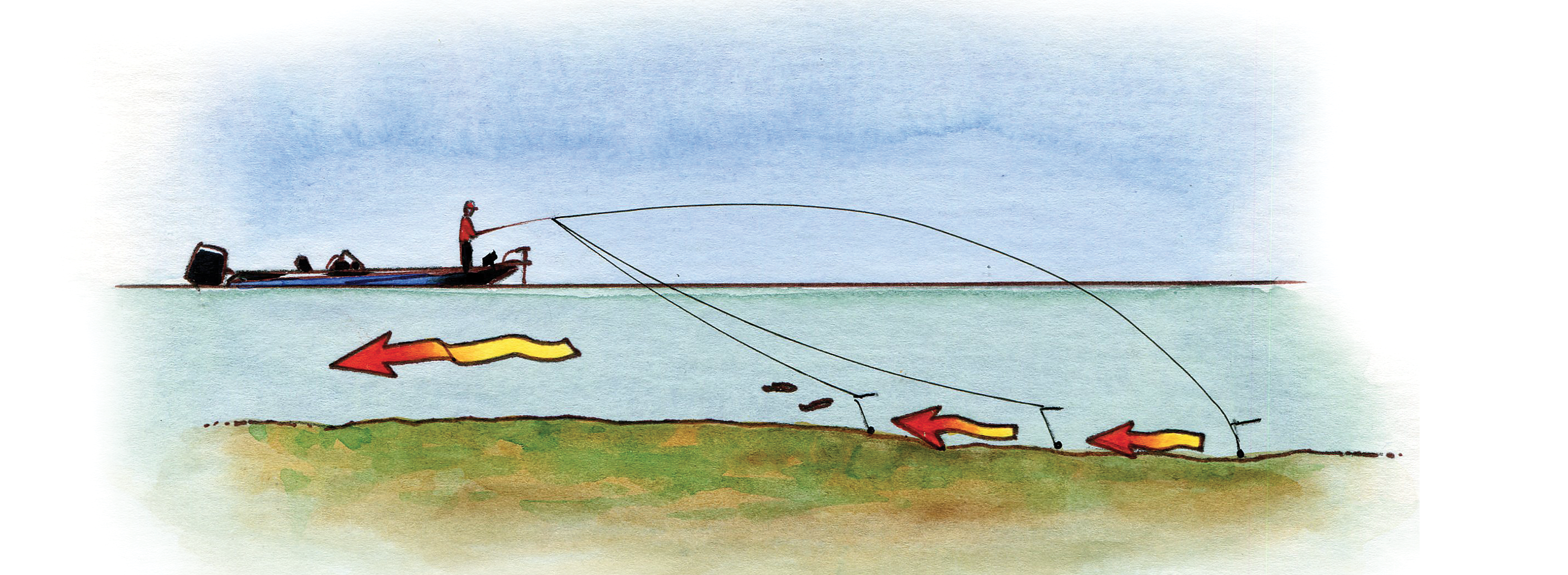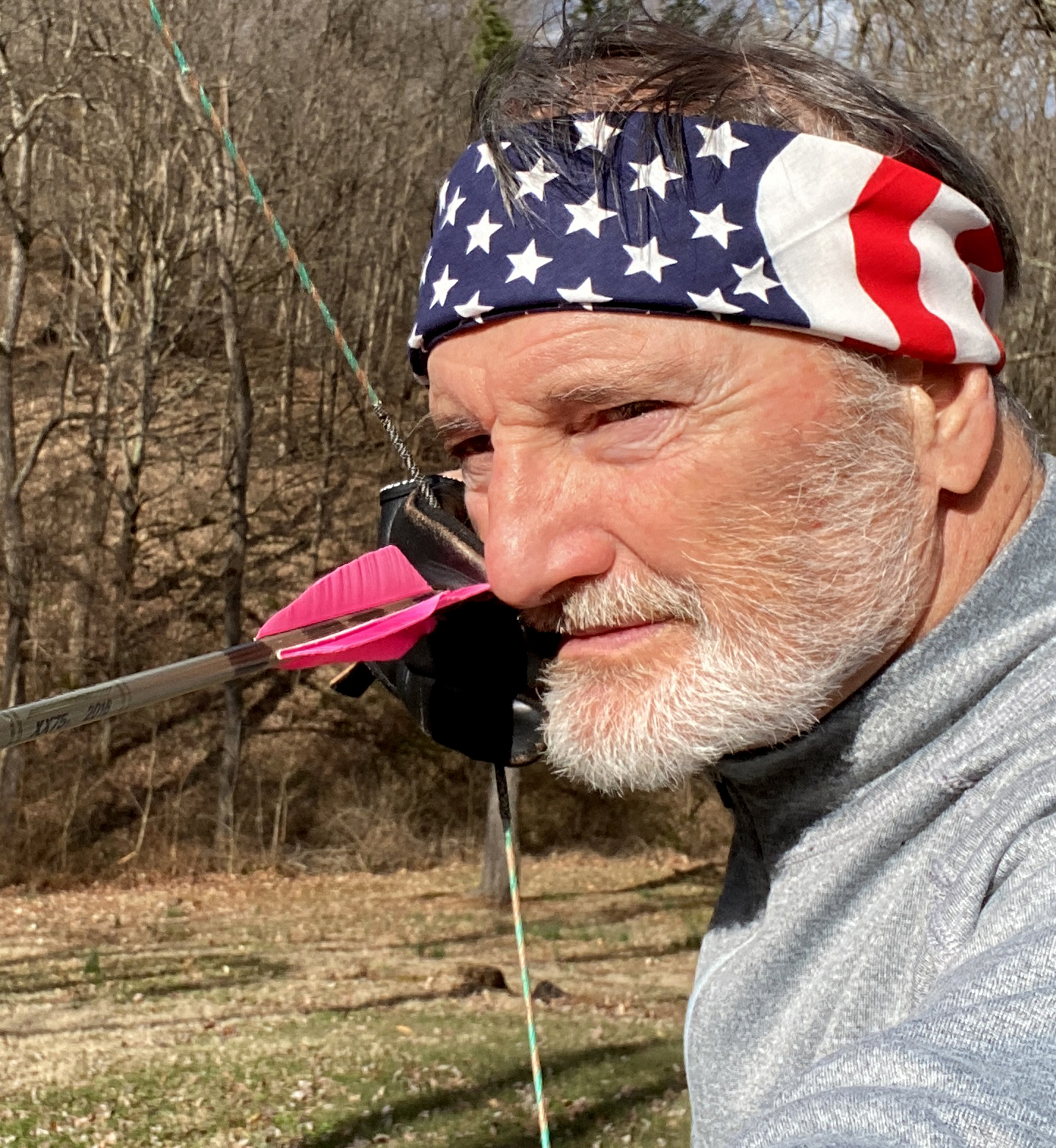
The drop shot may be the most versatile finesse technique in fishing.
Here are some of the most unique ways to present baits with this rig
The Bassmaster Elite Series pros have shown that there is far more to drop shotting than letting the rig sink straight down to the bottom and giving it a little shake and bake. As with other bass tactics, you must adjust the drop shot presentation to make the most of whatever conditions confront you. Here’s how five Elite pros make hay with a drop shot rig in specific situations.

Locked-Down Bass
Drop shotting becomes outright exasperating for Aaron Martens when temperamental bass demand a deadsticking presentation.
“It’s one of the hardest things to do,” Martens says. “It’s like slamming on the brakes.”
Fortunately for Martens — or unfortunately, depending on how you view his dilemma — he says deadsticking a drop shot is what he does best.
There have been several Elite Series tournaments in which Martens and other pros were drop shot fishing in a cluster. Martens says he has “smoked” the bass deadsticking while his competitors struggled to get bites.
This often happens in springtime when the bass are “floating around.” Then again, deadsticking comes through for Martens anytime the bass refuse to bite.
It’s not uncommon for 15 minutes to pass between casts when Martens deadsticks a drop shot rig. After the weight touches down, Martens lets the bait free-fall to the bottom. He lets it rest there for 10 to 20 seconds before slowly lifting it off the bottom without moving the weight. Then he lets the bait free-fall back down to the bottom for another long pause.
“I only do this when I know right where the bass are,” Martens says.
His most productive deadsticking setup is a 4.5-inch Roboworm Straight-Tail Worm nose-hooked with a No. 1 Gamakatsu G-Finesse Drop Shot Hook (also called the TGW Drop Shot Hook). This light hook allows the worm to slowly “float” to the bottom, which Martens says is the strike trigger. He goes with a 4- to 10-inch drop line in the spring and a 15- to 20-inch drop line in the fall.
The basic drop shot presentation for suspended bass is to let the rig sink straight down to the depth at which you see the bass on your graph. Then you hold the rig at that depth. A variation on this ploy allowed Kotaro Kiriyama to win an Elite Series tournament on Lake Erie out of Buffalo, N.Y., with 93 pounds, 6 ounces of smallmouth bass. The bass were suspended 50 feet deep below schools of baitfish where the bottom was 80 to 90 feet deep.
“It was like playing Super Nintendo,” Kiriyama says. “I would see the bass on my graph and let the drop shot sink straight down.”
The smallmouth reflexively nailed the bait as it plummeted past their noses. There was no need for Kiriyama to hold the drop shot rig above the bottom. His drop shot rig consisted of a 1/4-ounce sinker 12 inches below a Jackall Crosstail Shad nose-hooked with a No. 2 Owner Mosquito Hook.
During the February 2008 Bassmaster Classic at Lake Hartwell, Kiriyama opted for a 1/8-ounce weight to slow his drop shot rig’s fall because of the frigid water. About 12 inches above the weight, he Texas rigged a small shad-imitating bait on a 1/0 Owner J Light Hook.
Kiriyama’s bass were suspended 20 feet deep over submerged trees standing in 40 feet of water. He would cast over the trees and let his drop shot rig free fall. Many bites came as the rig was sinking. If the weight touched a tree limb before a bass nabbed the bait, Kiriyama would make five slow cranks on his spinning reel. If that didn’t provoke a response, he would reel in and make another cast. He caught enough suspended bass to claim seventh place.

Overcoming a Swift Current
Drop shotting in a swift current is one of the tactics that carried Kevin VanDam to victory during the 2016 Classic Bracket tournament on the Niagara River. His drop shot rig had to drift along at the same speed as the current to appear natural to the smallmouth, which were hugging the bottom on flats 5 to 10 feet deep. The weight of the sinker was the most critical factor.
“If the weight was too heavy, it would hang on the bottom and kill the bait’s action,” VanDam says. “If the weight was too light, the current would push it too fast to stay down.”
After casting upstream, VanDam let the current usher his drop shot rig downstream. Depending on the depth, a 3/16- or 1/4-ounce weight kept the sinker ticking lightly over the bottom.
The rig also consisted of 8-pound fluorocarbon line with a No. 2 Mustad Double Wide KVD Drop Shot Hook 12 inches above the weight. With heavier line, the current would have prevented the sinker from reaching bottom. The productive lure was a nose-hooked Strike King Drop Shot Half Shell, a baitfish imitator.
VanDam ups his drop shot weight to 3/8 or 1/2 ounce when fishing for smallmouth 30 feet deep in the strong current of the St. Clair and Detroit rivers connected to Michigan’s Lake St. Clair.
To achieve a natural drift in such deep water, VanDam holds the nose of his boat upstream with his electric motor and drifts backward downstream at the same pace that his drop shot rig ticks over the bottom directly beneath him.
Dart Or Undulate
No single drop shot bait is the best choice in every situation. One critical aspect is how the bait reacts in the water. During the 2016 Bassmaster Classic Bracket tournament on the Niagara River, Kevin VanDam relied on Strike King’s 3 1/2-inch Drop Shot Half Shell because it mimicked the shiners that the smallmouth were feeding on.
“When you shake the Half Shell … it has more of a dart to it, almost a jerkbait-type action,” VanDam says.
The Half Shell’s flat bottom and thin “fin” prompt the darting action that triggers bass to react. The same is true of Jackall’s 4-inch Crosstail Shad, which was introduced in 1999; Yum’s 3 3/4-inch Kill Shot; and Zoom’s 4-inch Z Drop Worm. Bass Pro Shops’ 3 3/4-inch, flat-bottomed Quiver Minnow has a similar action.
There are also many other deadly minnow imitators that have a darting or gliding action, including Berkley’s 3-inch PowerBait Power Minnow and Yamamoto’s 4-inch Shad Shape Worm.
Most other drop shot baits have an undulating action that teases bass to bite. Supple straight-tail worms head the list, including the Roboworms that Aaron Martens and Brent Ehrler dote on and the Havoc Bottom Hopper that Justin Lucas favors. Zoom’s Finesse Worm, Z-Man’s ElaZtec Finesse Wormz, Larew’s Tattletail Worm and Luck-E-Strike’s Con Man worm are also proven drop shot killers.
And, not all undulating drop shot baits are worms. For example, Missile Baits’ 3-inch Drop Craw features flopping claws that move with the slightest rod twitch.

Shallow Cover
Justin Lucas won an Elite Series tournament on the Potomac River in August 2016 by pitching a drop shot rig to thick wood pilings that supported an elevated parking deck. Because the pilings were planted in 4 to 8 feet of water, Lucas relied on a spinning outfit, which allowed his drop shot rig to sink straight down.
“With a baitcaster, I have to pull line off the spool to get a vertical drop when the water is deeper than 4 feet,” Lucas says.
Lucas matched his spinning outfit with 10-pound Berkley Fireline sporting a leader of 10-pound Berkley 100 Percent Fluorocarbon. A 3/16-ounce drop shot weight hung on the leader 8 inches below a straight-shank 1/0 hook. Whenever Lucas drop shots in shallow water, he goes with a 6-inch hand-poured worm or a 6.25-inch Berkley Havoc Bottom Hopper worm.
After he pitched to a piling at the Potomac, Lucas would drag the drop shot weight on the bottom until he felt it bump into some type of submerged cover. Then he would softly shake and pause the worm for 10 or 15 seconds before working it out for another cast. The unseen cover produced most of his bass.
Lucas learned this style of drop shot fishing growing up in California, where he used it to coax bites from bass lounging in the shade of docks. He has since used it to pluck bass from docks across the country.
In water less than 4-feet deep, Lucas pitches a 1/4-ounce drop shot rig with a baitcasting outfit and 12-pound fluorocarbon. He targets grass edges, laydowns, flooded bushes and any other shallow cover that might hold a bass.
“I fish it the same way I would a jig or a worm,” Lucas says.

Drop Shot Drag
Dragging a drop shot rig over the bottom like a Carolina rig pays off when you need to comb a point, ledge, reef or some other large bottom structure to pick off scattered bass. It keeps your bait cruising along above the bottom, whereas most Carolina rigged baits tend to inch along on the bottom. The bass may prefer one to the other at any given time.
Brent Ehrler does well dragging a drop shot for spotted bass at Shasta and Oroville lakes in his home state of California. This opportunity happens in fall and winter when the bass cluster in deep pockets that reach back from the main lake 50 to 75 yards or so. Ehrler holds his boat in the mouth of the pocket, typically over 50 feet of water, and casts toward the back of the cut, where the water is 20 to 30 feet deep. Then he drags his drop shot rig down the gut of the pocket, back to the boat.
“The bass are spread out, so you want to fish that broad depth range down the whole gut,” Ehrler says. “I don’t know why, but they’ll hit the drop shot when I drag it, but they won’t when I shake it on the bottom.”
No doubt there are similar pockets on spotted bass lakes elsewhere in the country where dragging a drop shot could pay off. Ehrler’s basic drop shot setup works well in this situation. It consists of a spinning outfit matched with 12-pound Sunline braid attached to a 10-foot leader of 8-pound Sunline FC Sniper. A 1/4-ounce tungsten drop shot weight hangs 14 inches below a 4- or 6-inch Roboworm nose-hooked with a No. 1 Gamakatsu Drop/Split Shot hook.
Originally published in Bassmaster Magazine 2017.






